| This article needs additional citations for verification. Please help improve this article by adding citations to reliable sources. Unsourced material may be challenged and removed. Find sources: "Masaya" – news · newspapers · books · scholar · JSTOR (February 2013) (Learn how and when to remove this message) |
Municipality in Masaya Department, Nicaragua
| Masaya | |
|---|---|
| Municipality | |
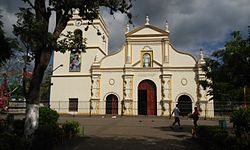 La Asunción church in the Central Park of Masaya La Asunción church in the Central Park of Masaya | |
 Flag Flag Seal Seal | |
 | |
| Coordinates: 11°58′N 86°06′W / 11.967°N 86.100°W / 11.967; -86.100 | |
| Country | Nicaragua |
| Department | Masaya Department |
| Government | |
| • Mayor | Orlando Noguera |
| Area | |
| • Municipality | 57 sq mi (147 km) |
| Population | |
| • Municipality | 191,574 |
| • Density | 3,400/sq mi (1,300/km) |
| • Urban | 138,657 (4th Nicaragua) |
Masaya (Spanish pronunciation: [maˈsaʝa]) is the capital city of Masaya Department in Nicaragua. It is situated approximately 14 km west of Granada and 31 km southeast of Managua. It is located just east of the Masaya Volcano, an active volcano from which the city takes its name. With an estimated population of 138,657 (2022), it is Nicaragua's fourth most populous city, and is culturally known as the City of Flowers.
History
It is believed that the Nicaraos were the first people to dwell in the land of Masaya (the Chorotegas had also inhabited these areas). There is evidence of their settlements in small towns like Nindiri, Niquinohomo and Monimbó from before the Spanish Conquest. One of the city's principle neighborhoods is Monimbó (which in Spanish means "close to the water") and is located very close to the lagoon. There is documented evidence that in the 6th century, Monimbó had a population of about 150 tribes.
Pedrarias Davila initiated the conquest of what is now Masaya in 1524 and created the first encomiendas. Since Masaya is located on the main road from Granada to León, as well as the road to Panama, it soon developed into an appropriate resting place for travelers. Due to its nice climate and fertile soil, many people were drawn to settling in the city, thus creating the colonial city of Masaya.
On 24 March 1819, the King, Ferdinand VII of Spain, granted Masaya the title of "Very Noble and Loyal Village Faithful to San Fernando of Masaya" that you can still read on the city's coat of arms today. Additionally, the city's coat of arms says, "Long Live the Heart of Mary". On 2 September 1839, Masaya was officially declared a city.
Of all the different indigenous settlements, only Monimbó has conserved its ethnic identity over time.
On 19 September 1912, during the Nicaraguan civil war of 1912, Nicaraguan rebel forces opened fire on American Marines and sailors passing through the city on their way to Granada. This became known as the Battle of Masaya.
Production
Masaya is located centrally to a large agricultural production region in Nicaragua. Much of the production from the departments of Masaya and Carazo and the surrounding areas is shipped through Masaya on its way north, towards Managua and Leon. Masaya is also a notable industrial center, producing footwear and clothing. Other industries in the city include the processing of fiber and the manufacture of cigars, leather products, soap, and starch. Many of the communities surrounding Masaya produce hardwood and wicker furniture, and there is a neighborhood in Masaya near the lake dedicated to the production of hammocks.
Attractions
| This section does not cite any sources. Please help improve this section by adding citations to reliable sources. Unsourced material may be challenged and removed. (January 2023) (Learn how and when to remove this message) |
Masaya is known as "The Cradle of Nicaraguan Folklore" and is the very heart of Nicaraguan handicrafts. The main market in Masaya is located next to the central bus station. The market is divided into sections, with each section serving a different need. Aside from unique Nicaraguan products such as hand woven hammocks, embroidered blouses, wood carvings, and hemp weaving the market is very diverse. An entire section of the market is dedicated to selling electronic devices and clothing, while another area is reserved for raw meat. Everything is available in the market from hardware and beauty supplies to produce from the surrounding area.
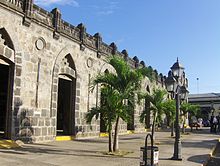
The Mercardo de Artesanias (Craft Market) is located inside what used to be the "mercado viejo" (old market), a 1900s structure that is located near the center of the city and a couple of blocks away from the general population market. This market has been revitalized and set as a tourist spot, where crafts from Masaya and other areas of Nicaragua can be found. In addition, every Thursday night there is a Noche de Verbena or Night of Revelry, where folkloric dances are presented. Masaya is noted for the annual fall fiesta of San Jerónimo which features folkloric dances and other street processions, such as the carnivalesque "Torovenado" celebrations, which often have groups and individuals who perform satires of local and national political figures.
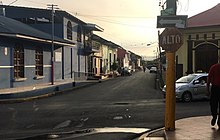
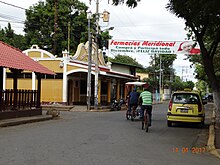
The historical city center has open plazas and two large 16th-century baroque architecture churches: the Assumption's Parish Church, and St. Gerome's Church. But there are other colonial gems like St. John's, St. John Bosco's, and St. Michael's.
Masaya is actually the name of one of Nicaragua's Departments, which the city of Masaya is the head of. In addition to Masaya, the department includes the municipal cities of Catarina, Nindirí, Masatepe, Tisma, Niquinohomo, Nandasmo, San Juan de Oriente and La Concepción.
Masaya Volcano
Main article: Masaya Volcano
Volcán Masaya National Park is a popular tourist site. It has a small museum and tourist information. Tour guides and proper equipment are provided for treks inside bat caves created by lava flows from past eruptions. Today, lava can be visible in the volcano's crater. Masaya is the most active volcano in the region. It is actually made up of two volcanoes: Masaya and Nindirí with a total of five craters. The Spanish first described the volcano in 1524 and believed the belching lava to be melting gold. But when Fray Bartolomé de las Casas first saw it he called it the "Gates of Hell". Since then, Masaya Volcano has erupted at least 19 times. From 1965 to 1979 the volcano contained an active lava lake. The last reported eruption event was in 2003, when a plume reportedly shot ~4.6 km into the air. Masaya is an unusual basaltic volcano because it has had explosive eruptions. An eruption in 4550 B.C. was one of the largest on Earth in the last 10,000 years.
Apoyo Lake
The City of Masaya is also located west of a large, deep crater lake named "Apoyo". which is part of the Apoyo Lagoon Natural Reserve. This lake is a popular attraction in the area, and is host to several hostels and small resorts. Apoyo's crater measures four miles wide and over 656 feet deep. Major activities include fishing, water sports and scuba diving. Archaeological researchers have found evidence of pre-colonial occupation.
Coyotepe Fortress

Coyotepe is an old fortress located on a sharp, hill from where it takes its name which has now been converted into a museum. Built at the turn of the 20th century by President José S Celaya, this site witnessed a fierce battle on October 2–4, 1912, when a Nicaraguan rebel force led by General Benjamín Zeledón occupying Coyotepe and another hill overlooking the strategic rail line, Barranca, refused to surrender to government troops under President Adolfo Díaz. U.S. Marine Major Smedley Butler's marine battalion, that Zeledón's rebels had skirmished with on September, 19, returning from Granada, Nicaragua on October 3, shelled the rebel stronghold on Coyotepe. During the pre-dawn hours on October 4, Butler's battalion, in concert with two marine battalions and one from the USS California led by marine Colonel Joseph H. Pendleton converged from different positions to storm the hill and capture it. Also General Benjamín Celedón was killed, at the age of 33, and his dead body dragged from a trotting horse, to instill fear among the population and to prevent a potential uprising. But quite to the contrary, Celedón's death was the spark that inspired Augusto C Sandino and other famous figures to fight for 7 years, in the Segovias in the Northern Nicaraguan mountains, against the cruel invaders. President Anastasio Somoza rehabilitated the fortress in the late 1930s and it was used as a detention facility during periods of civil unrest. In the 1950s it was used to train Guatemala radio operators that supported the CIA organized Operation PB Success that successfully overthrew President Jacobo Arbenz, a left leaning Army Colonel in 1954. From the 1950s onward it was used as a dump for obsolete army materiel. In the 1960s, another President Somoza ordered it to be donated to the Boy Scouts Organization.. For many years Coyotepe remained a military outpost but it was given away to the Boy Scouts Association by the 1970s. The fortress built in the 19th century has 43 jail cells, 28 of them on the upper floor, where windows let the air and sunlight in. Each of the upper floor cells could contain from 15 to 20 prisoners, sometimes even more. The basement cells, on the other hand, resembled a dungeon for they were dark, damp, stuffy, and cramped so prisoners would lose track of time and inevitably ended up with psychological trauma. In all in its early years at the turn of the century, there were about 1,000 prisoners at any one time. Nevertheless, as time went on, the site was abandoned by the Boy Scout Association from 1983 to 1992. During that period, there were rumours among the population that Coyotepe was used as a sanctuary for Satanic practices for there was no proper security. Finally, the new neoliberal governments that won the elections in 1990, finally returned Coyotepe to the Boy Scouts Association.
Gastronomy
| This section does not cite any sources. Please help improve this section by adding citations to reliable sources. Unsourced material may be challenged and removed. (January 2023) (Learn how and when to remove this message) |
Masaya boasts a varied culinary tradition based on pre-Columbian recipes. Nacatamal is a giant tamal, made of corn flour sprinkled with annatto and salt, and mixed with pork, bacon, a bit of rice, potato slices, onions, tomatoes, green peppers, mint, Congo chilis, and prunes. Then everything is covered in plantain leaves, tied up with ropes, and boiled for a couple of hours on a giant pot. Nacatamals are normally eaten at breakfast or supper with a loaf of bread and black coffee.
Vaho is another heavy meal, normally eaten at lunch. It consists of thick, long slices of salted, dried beef marinated in sour orange juice. The beef is mixed with yucca, green plantains, ripe plantains, tomatoes, onions, garlic, cabbage, and placed on a pot with the interior walls lined with plantain leaves, and then covered with the same leaves and a lid, and steamed slowly. Vaho is eaten with tortillas. Yucca tubers are essential to Masayan food whether boiled, steamed, fried, or broiled and used in many different dishes such as vigorón. Vigorón consists of boiled yucca, topped with sweet-and-sour cabbage cut into strips, diced tomatoes, onions, green currants, Congo chilis, vinegar, and salt.
Notable people
- Enrique Bolaños, former Nicaraguan president
- Olga Núñez Abaunza, first Nicaraguan female lawyer
Twin towns – sister cities
 Belo Horizonte, Brazil
Belo Horizonte, Brazil Cartago, Costa Rica
Cartago, Costa Rica Dietzenbach, Germany
Dietzenbach, Germany Leicester, England, United Kingdom
Leicester, England, United Kingdom Nijmegen, Netherlands
Nijmegen, Netherlands
Notes and references
- Citypopulation.de Population Masaya municipality
- Citypopulation.de Population of the major cities in Nicaragua
- Perez, Max; Quintero, Glenda; Amoretty, Ezequiel. "Masaya la "Ciudad de las Flores"" [Masaya "the City of Flowers"] (in Spanish). Inside Managua. Archived from the original on 18 February 2018.
- Garcia, Nary (6 December 2009). "Bailes de Negras: tradición y cultura" [Black Dances: tradition and culture]. El Nuevo Diario (in Spanish). Archived from the original on 18 February 2018.
- Carmack, Robert (2017). The Indigenous People of Mesoamerica and Central America. Lexington Books. pp. 81–83. ISBN 9781498558976.
- El Banco Central de Nicaragua, Fundación Andrés Vega Bolaños (2006). Memorial de Masaya. PAVSA. p. 85. ISBN 99924-59-66-2.
- Romero, German; et al. (1992). Persistencia indígena en Nicaragua. Managua: CIDCA-UCA. p. 107.
- Musicant, Ivan (1990). The Banana Wars: A History of United States Military Intervention in Latin America from the Spanish–American War to the Invasion of Panama. New York: Macmillan. pp. 150–151. ISBN 978-0-02-588210-2.
- Clark, George Bransfield (2001). With the Old Corps in Nicaragua. Novato, California: Presidio Press. p. 12. ISBN 978-0-89141-737-8.
- Langley, Lester D. (1983). The Banana Wars: An Inner History of American Empire, 1900–1934. Lexington, Kentucky: University Press of Kentucky. p. 68. ISBN 978-0-8131-1496-5.
- Bundschuh, Jochen; et al. (2007). "Chapter 34: Geology-related tourism for sustainable development". In Bundschuh, Jochen; Alvarado, Guillermo E. (eds.). Central America: Geology, resources and hazards (PDF). Vol. 2. London: Taylor & Francis. pp. 1014–1098, page 1022. ISBN 978-0-415-40169-2.
- American Naval History, An Illustrated Chronology of the U.S. Navy and Marine Corps, by Jack Sweetman, p. 114
- "Cidades Irmãs de Belo Horizonte". portalbelohorizonte.com.br (in Portuguese). Belo Horizonte. Retrieved 4 December 2020.
- "En Masaya y Cartago, Actuemos Ya en contra de la xenofobia, con el hermanamiento". elaventinonicaragua.com (in Spanish). El Aventino. 25 February 2020. Retrieved 4 December 2020.
- "Partnerstädte". dietzenbach.de (in German). Dietzenbach. Retrieved 4 December 2020.
- "Chongqing, Masaya and Strasbourg: everything you need to know about Leicester's twin cities". leicestermercury.co.uk. Leicester Mercury. 17 February 2019. Retrieved 4 December 2020.
- "Internationale samenwerking". nijmegen.nl (in Dutch). Nijmegen. Retrieved 4 December 2020.
External links
11°58′N 86°06′W / 11.967°N 86.100°W / 11.967; -86.100
| Capital: Masaya | ||
| Municipalities | 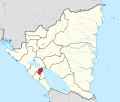 | |